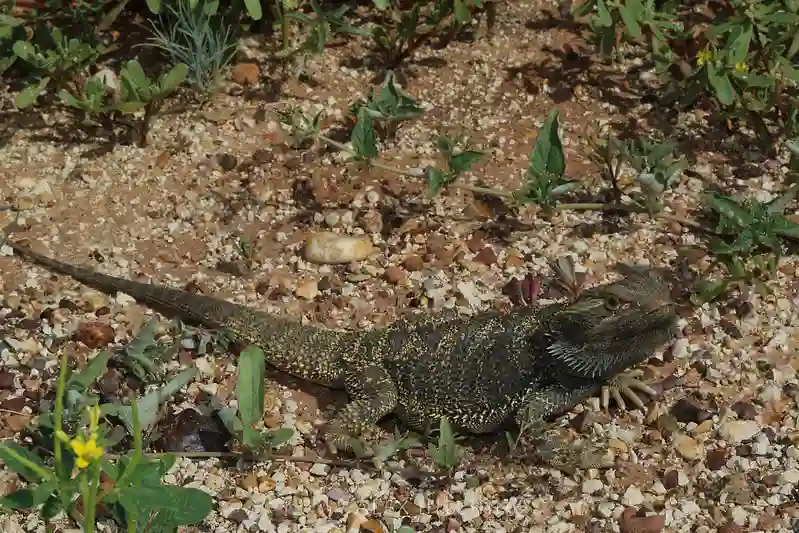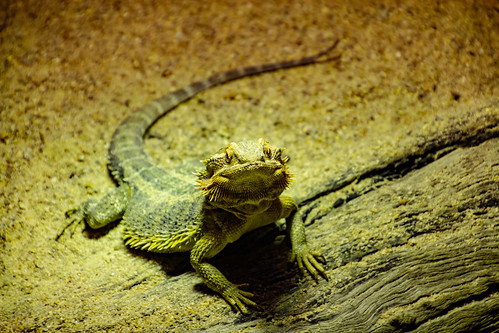A black tail on a bearded dragon can be a sign of tail rot, a serious condition that should be addressed quickly.
Tail rot is caused by a lack of healthy blood supply to the tail and is usually the result of an infection, trauma, or wound on the tail. Here are some signs of tail rot in bearded dragons:
- The tail turns black, purple, or blue
- The tip of the tail becomes dark brown or black
- The tail becoming dry and brittle
- A part of the tail is really dry and has an unusual color
- The skin on the tail flaking off or seems dry
- Dehydration
- The appearance of scaly skin layers and intense dryness
If you suspect that your bearded dragon has tail rot, it is important to take them to a veterinarian as soon as possible. Tail rot can spread to other parts of the body and harm internal organs.
Causes of Black Tail Coloration
Black tail coloration in bearded dragons can indicate an underlying health issue or other problem that needs to be addressed promptly. The most common cause of black tail coloration is shedding.
As bearded dragons grow and develop, they periodically shed their skin to allow for new growth and development. During this process, the old skin may appear darkened or discolored before it falls off entirely.
Black tail coloration may also indicate more serious issues such as injury or infection. If your bearded dragon’s tail suddenly turns black without any apparent cause related to shedding, it may signal something more serious is going on with your pet reptile’s overall health.
Reasons for Black Tail Coloration in Bearded Dragons
Shedding process
Bearded dragons go through a shedding process, where they shed their old skin to make way for new growth. This is a completely normal and natural process, but it can often result in some changes to the color of the tail.
During shedding, the skin on the tail will appear duller or darker, giving the appearance of a black color. This is because the old skin is loosening and separating from the new skin underneath.
Shedding cycle and frequency
The shedding cycle of bearded dragons varies depending on their age, diet, and overall health. Juvenile bearded dragons tend to shed more frequently than adults because they are growing at a faster rate.
Adult bearded dragons typically shed every 4-6 weeks. However, if your bearded dragon’s tail remains black beyond its shedding cycle or sheds too frequently or not frequently enough, consult with an exotic veterinarian.
How shedding affects the tail color
Due to how shedding works for bearded dragons and their body structure, one must know that different body parts may shed at different times causing discrepancies in coloration that might visually affect their appearance. The change in tail color during shedding should not last long after the completion of this natural process; however, if it does persist or worsens over time this may indicate other underlying issues.
Injury or Trauma
Injury or trauma can also cause black coloring on a bearded dragon’s tail. This usually occurs as a result of physical damage to the tail such as being accidentally stepped on, having something fall onto it, or getting caught near door hinges.
Common injuries that cause black tail coloration
Two common violent incidents include MBD (metabolic bone disease) and tail rot. MBD is a calcium deficiency that can cause muscle weakness and deformities, including a blackened tail. Tail rot is a bacterial infection that can develop from an injury to the tail that becomes infected, causing the tissue to die off and turn black.
Treatment options for injured tails
If your bearded dragon has suffered an injury or developed tail rot causing their tail to turn black, it is important to seek veterinary treatment immediately as these conditions require specialized attention. While MBD can be prevented with proper diet, treatment for infected tails includes antibiotics and surgery in severe cases where the tissue has become necrotic (dead).
Prevention and Care for Black Tails in Bearded Dragons
Maintaining Proper Temperature and Humidity Levels
Bearded dragons require appropriate temperature and humidity levels to maintain healthy skin and tail coloration. Improper temperature can cause the tail to turn black, which can be an indication of poor health. The ideal temperature range for bearded dragons is between 85-105°F (29-40°C).
On the other hand, humidity levels should be kept between 30-40% during the day, with a slight increase at night. To achieve optimal humidity levels, it’s essential to provide a water bowl in their enclosure and mist regularly.
Dietary Considerations
Nutrition is vital for maintaining healthy skin, scales, and tails in bearded dragons. These lizards need a well-balanced diet with a variety of fruits, vegetables, insects (such as crickets or mealworms), and commercial pellet food. Lack of adequate nutrition can lead to improper shedding or even metabolic bone disease.
Nutritional Requirements for Bearded Dragons
Bearded dragons require different nutrients at different stages of life; therefore feeding should vary depending on their age. Juveniles require more protein than adults as they are still growing; therefore insects should comprise about 80% of their diet while adults need more greens than protein as they grow very slowly or not at all.
How Diet Affects the Health of Their Tails
A proper diet rich in vitamins A & D is essential for maintaining healthy skin coloration on their tails. Vitamin A helps support immune function while Vitamin D aids calcium metabolism which prevents metabolic bone diseases like MBD that leads to black tail coloration amongst other things like deformed bones – this condition could potentially kill your beardie if left untreated.
Conclusion
Summary of Key Points Discussed in the Article
In this article, we discussed the various reasons why a bearded dragon’s tail may turn black. We examined the normal tail colors and patterns of bearded dragons and looked at what might cause black coloration, such as shedding or injury.
We also explored ways to prevent and care for black tails, including maintaining proper temperature and humidity levels, providing a nutritious diet, and seeking prompt veterinary care if an injury occurs.
The Importance of Monitoring Your Bearded Dragon’s Health, Including Their Tail Color
Bearded dragons are fascinating pets that require special attention to their health needs. One important aspect to monitor is their tail color. Changes in color can signal a potential problem that requires medical attention or adjustments to their environment or diet.
Proper care of your bearded dragon includes monitoring their behavior, appetite, bowel movements, and overall appearance on a regular basis.
By being vigilant about the health of your bearded dragon and taking proactive steps to prevent issues with their tails, you can help ensure that they remain healthy and happy pets for many years to come.
Remember to provide them with a comfortable habitat that mimics their natural environment as much as possible, feed them properly balanced meals with plenty of variety, keep them hydrated with fresh water daily, and seek prompt veterinary care if any concerns arise.
While it may be alarming when your bearded dragon’s tail turns black or shows signs of distress or injury- by staying informed about the possible causes behind this phenomenon you can take proactive steps towards avoiding such negative impacts; moreover with proper preventive measures in place- your beardie should remain healthy & happy throughout its life.


